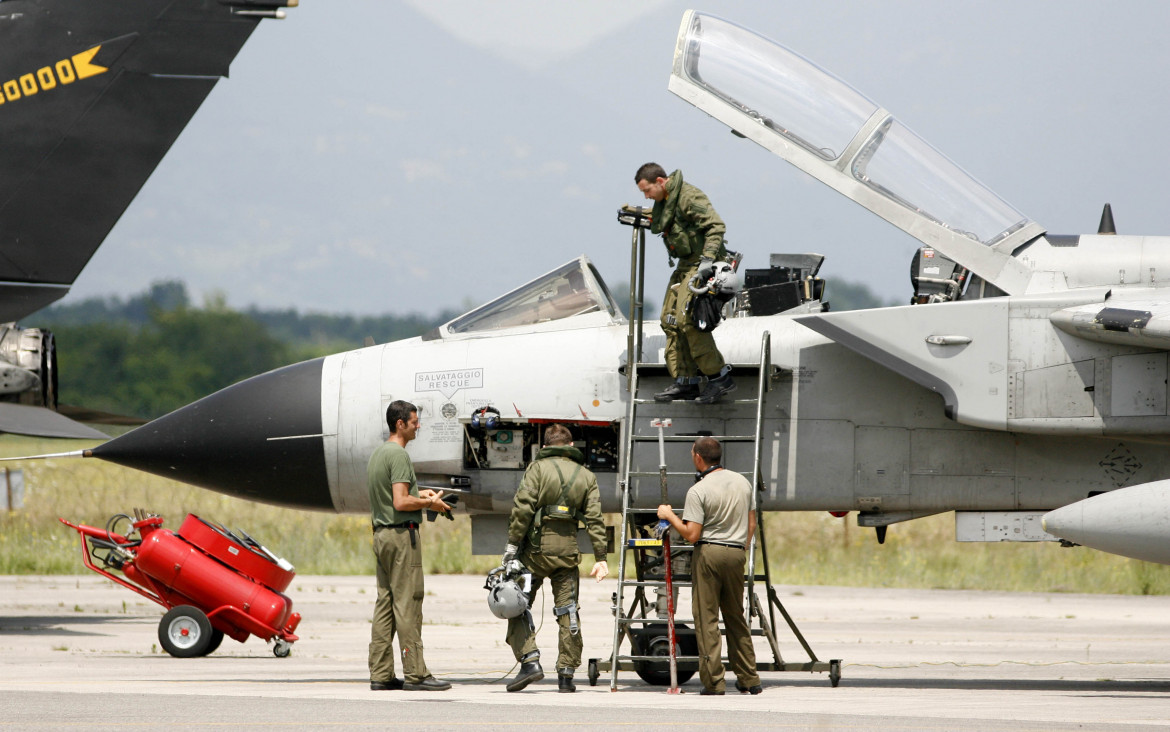Ghedi Air Base - A new sign at Gedi Air Base indicates that the base houses US nuclear weapons that have protected "the free nations of the world" since the end of the Cold War. But where is the proof?
In December 1963, a shipment of American nuclear bombs arrived at Geddi Torre Air Base in northern Italy. Half a century later, nuclear bombs are still deployed at the US Air Force Base.
Ghedi Air Base

The US-Italy nuclear partnership was celebrated in Basel in January. One poster described the "NATO nuclear mission" as Geddick "saved the world's free nations..."
Ghedi Stock Photos
This may have happened during the Cold War when NATO faced an imminent threat from the Soviet Union. But half of the nuclear mandate at Gedi is over
The end of the Cold War without imminent threats requiring the extensive deployment of nuclear weapons in Europe.
Instead, NATO's nuclear mission is now seen as an economic and political burden on NATO, robbing its armed forces of money and time spent on non-nuclear missions, obfuscating NATO's nuclear arms control message, and providing false security to NATO's Eastern allies.
Neither the US nor the Italian government confirms that Gedi Torre Air Base has nuclear weapons. The annual poster doesn't even include the word "nuclear", instead referring to the "NATO mission".
Us Soldiers Expose Nuclear Weapons Secrets Via Flashcard Apps
Munitions Support Squadron (MUNSS), a US Air Force unit of approximately 134 personnel responsible for protecting and maintaining the 20 US B61 nuclear bombs at the base. MUNSS would not be on base without nuclear weapons. The US Air Force has only four MUNSS units, all deployed to four European bases intended to deliver US nuclear weapons via host nation aircraft.
A satellite photo from March this year shows part of the nuclear infrastructure at Geddy Torre Air Base. Click on the image to view it in full size.
Another clue is the presence of NATO weapons maintenance trucks (WMT) at Gedi. NATO has 12 trucks specially designed to enable field service of nuclear bombs at storage bases in Europe. A satellite image provided by DigitalGlobe via Google Earth shows a WMT parked near the 704

MUNSS Quarters, Gedi on 12th March 2014. An older image from September 28, 2009 shows two WMTs in the same location (see image above).
In The Town Of Ghedi, Residents Coexist With Nuclear Warheads And A Nato Base
These trucks will go to 11 individual aircraft protection shelters (PAS) with underground weapons storage and security (WS3) vaults to serve the B61 bombs. WS3 laps at Gedi were completed in 1997; Prior to that, weapons were stored in bunkers outside the main base. Once the truck is inside the shelter, the B61 is removed from the vault, disassembled into its major parts as needed, and brought to the truck for service.
It was during this disarmament process that the nuclear bomb's electrical exclusion zones collapsed, and a 1997 US Air Force safety review warned that "a nuclear explosion could occur" if lightning struck the shelter.
NATO is replacing the WMTs with a fleet of new nuclear weapons maintenance trucks known as the Secure Transportable Maintenance System (STMS). Trailers will have better lightning protection. NATO paid $14.7 million for the program in 2011, and in June 2014 the US Air Force awarded five US companies a $12 million contract in July 2012 to build 10 new STMS trailers.
NATO's new mobile nuclear weapons management system is scheduled to be delivered to European nuclear bases in 2014. Click image to view full size.
Beretta Celebrates The First 40 Years Of The Tornado Fighter Jet
The new trailers will be able to handle the new B61-12 guided separation nuclear bomb planned for deployment in Europe in 2020. The B61-12 will be approximately 100 pounds (~45 kg) heavier than the existing B61s in Europe. . (see slide below), even without an internal parachute. This implies that a fair amount of new or revised components will be added. For better handling of the heavy B61-12, each trailer is equipped with lift rails.
The new B61-12 bomb will be heavier than the B61 currently deployed in Europe. For pictures of the B61-12's original specifications, click here.
The deployment to Gedi more than 50 years ago was not the first or only deployment of US nuclear weapons in Italy. During the Cold War, ten different US nuclear weapons systems were deployed in Italy. The Corporal and Honest John short-range ballistic missiles arrived in August 1956. Atomic bombs followed in April 1957 and nuclear landmines in 1959. Since then, all but one of these nuclear weapons systems have been removed and scrapped.

A decade ago, Germany and the UK housed most of Europe's B61s, but today, Italy holds the distinction of being the NATO country with the most US nuclear weapons deployed on its soil. 70 (39%) of the remaining 180 B61 bombs in Europe. Italy is also the only country with two nuclear bases: the Italian Gedi Base and the American Aviano Base. Aviano Air Force Base is home to US 31
During The Morning Open Ranks Inspection, Us Air Force (usaf) Staff Sergeant (ssgt) Courtney Robinson (right), 831st Munitions Support Squadron (mss), Security Forces Flight Sergeant, Briefs His Flight On The Daily Assignments
The Stormo Wing at Gedi Torre Air Base indicates that Italian Tornado aircraft were equipped and Italian Tornado pilots trained in peacetime to deliver US nuclear weapons during wartime. The agreement predates the Nuclear Non-Proliferation Treaty (NPT), but it is more controversial because Italy, a signatory to the NPT, has pledged "not to accept the transfer of a nuclear weapons donor . . . nor the control of such weapons." . . . directly or indirectly."
The United States, a signatory to the NPT, is also “committed not to transfer nuclear weapons to any recipient or… control these weapons, directly or indirectly; Without being able in any way to assist, encourage or induce any non-nuclear-weapon state to acquire nuclear weapons...or to control such weapons...”
MUNSS, but the whole purpose of the NATO mission is to equip, train and prepare in peacetime for the "transfer" and "control" of US nuclear bombs to the Italian Air Force in the event of war.
Maintaining NATO's nuclear strike mission in Europe is neither cheap nor easy, but it "steals" scarce resources from non-nuclear military capabilities and operations, unlike strategic nuclear bombs, which are important to NATO.
Through The Lens: Frisian Flag 2022
MUNSS at Gedi for security upgrades needed to protect weapons at the base, train pilots and maintain Tornado aircraft to meet stringent certification requirements for nuclear attack weapons. Additionally, the cost of securing B61 bombs at European bases is expected to more than double over the next few years (to $154 million) in order to meet US high security standards for 'nuclear weapons storage'.
But given the serious economic challenges facing Italy, these costs are increasingly difficult to justify. The Air Force's annual flight hours fell from 150,000 in 1990 to 90,000 in 2010, training fell 80 percent between 2005 and 2011, and training for air operations other than Afghanistan has apparently prepared it "to the bone." Additionally, Italy's defense posture is in the midst of a 30 percent contraction in overall operational network, logistics and headquarters spending. The F-35 fighter-bomber program has already been cut by a third to replace the current fleet of Tornados in the nuclear strike mission, and the new government has signaled plans to cut more programs.
The United States bears most of the costs of the European nuclear mission. Over the next decade, the United States plans to spend about $10 billion to upgrade the B61 bomb, more than $1 billion to adapt the new guided B61-12 to four existing aircraft, and $350 million to build the new F-35 stealth. the fighter - a nuclear-capable bomber and another $1 billion to maintain deployments in Europe.
About $12.5 billion will be spent on maintaining, securing and upgrading US nuclear bombs in Europe over the next decade. The cost must be clearly weighed against the security benefits it provides to NATO, how the deployment fits with US and NATO nuclear arms control policy, and the most important defense needs that would benefit from this level of funding.
Nd Fw Leadership Visit Ghedi Air Base
An annual poster displayed at Gedi Air Base claims that even after the end of the Cold War, US non-strategic nuclear bombs "saved the world's free nations". During a nuclear security exercise in Gedi in January, the U.S. Air Force Commander 52
As our country regards the Soviet Union as a valuable member of our eternal alliance.” (Emphasis added).
This is an exaggeration to say the least. Indeed, it is hard to find evidence that the deployment of non-strategic nuclear weapons in Europe since the end of the Cold War has saved anything, or that the mission is even remotely relevant today. The biggest challenge
Military drone range, laser range finder military, military range bags, military range targets, long range military radio, military radio range, military range finder, military long range binoculars, range rover military discount, military range rover, range of military drones, military range bag
0 Comments